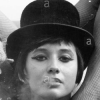A genuine spherical environment texture map contains all the degrees of spherical visual information present in that distorted image. You can read more about it here:
http://www.pauldebevec.com/ReflectionMapping/
If you have a single square image you can distort that image from the center to the edges relative to a sine function and it should work as a spherical environment texture map, but it will lose detail. If it were a cubemap, it would be like starting with only the front face and stretching it to cover the other faces.
You can use the Spherize filter in Photoshop to do this, or any other image editing trick such as ImageMagick:
- http://www.imagemagick.org/Usage/mapping/#spherical
- http://www.fmwconcepts.com/imagemagick/bubblewarp/index.php
GIMP does not have a "spherize" filter. The Polar Coordinates filter is not a replacement for this, it does something else. It's possible to write a GIMP Python-Fu script to do a "sine warp" as explained in that "bubblewarp" page.
A reference GIMP Python-Fu script is the following. It's unrelated to this task, but it's a template that you can use and replace the pixel-manipulation logic with anything you want, such as that sine warping:
http://paulbourke.net/texture_colour/tiling/polarCorrection.py
Let me just say that Python-Fu has terrible documentation (it's better to read the code samples), and that Python itself can be very frustrating if you're used to languages that don't enforce any formatting restrictions, like C++. A single blank space can stop GIMP from executing your Python script because it breaks indentation.
Some further reading:
- https://msdn.microsoft.com/en-us/library/windows/desktop/bb147401(v=vs.85).aspx
- http://paulbourke.net/texture_colour/tiling/ (At the bottom)








